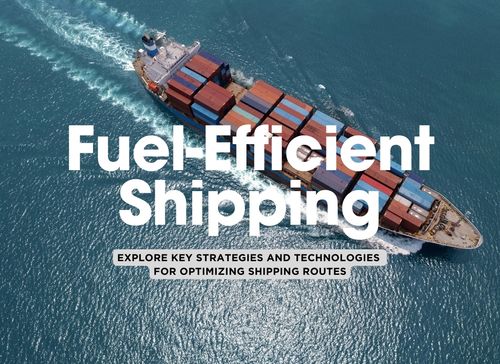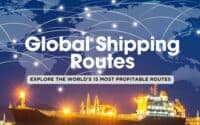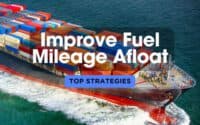Fuel-Efficient Shipping Routes: An In-Depth Guide for Shipowners on Major Trade Lanes

Fuel efficiency in shipping is more than just about saving fuel; it’s about keeping costs down, meeting environmental goals, and maximizing profit over time. By optimizing shipping routes, shipowners can cut down on fuel expenses, reduce wear and tear on ships, and even extend the lifespan of the fleet. For those shipping across major trade lanes, small adjustments in routing and timing can add up to big savings. Here’s a quick breakdown of some of the top benefits shipowners can expect from fuel-efficient routes:
| ShipUniverse: Benefits of Fuel-Efficient Shipping Routes | |
|---|---|
| Benefit | Detailed Description |
| Lower Fuel Costs | Using optimized routes means less fuel burned per voyage. For example, a tanker on a typical route can save up to 15% in fuel costs by adjusting for currents and weather. Over a year, that can mean tens of thousands in savings per vessel – which adds up when you’re running a fleet. Less fuel used = lower costs. |
| Reduced Emissions | Fewer fuel emissions not only help with environmental impact but also keep you compliant with tightening regulations. A reduction of even 10% in fuel use can significantly reduce CO₂, sulfur oxides, and other harmful emissions. In the eyes of regulators and eco-conscious partners, this can enhance your reputation and make your fleet more attractive to charterers. |
| Extended Ship Lifespan | Efficient routes place less strain on engines and hulls, which means lower maintenance costs and longer service life. By avoiding rough seas and high-speed runs, you reduce the wear and tear on critical components. This leads to fewer repairs and postpones the need for major overhauls or replacements, ultimately keeping your fleet in action longer. |
| Improved Scheduling | With optimized routing, voyages are more predictable, allowing you to build reliable schedules. This predictability helps avoid unexpected delays and penalties, which can improve relationships with clients and partners. When you can accurately calculate arrival times, it’s easier to manage operations at both departure and destination ports. |
| Increased Profit Margins | The cumulative effect of lower fuel costs, fewer emissions-related fines, extended ship life, and timely deliveries means greater profit margins. For shipowners, every dollar saved on operations is a dollar earned, and even small efficiencies can yield substantial returns over time. Optimized routing is an easy way to boost your bottom line without major investments. |
| Enhanced Competitiveness | With rising fuel costs, clients and partners are looking for providers who can deliver at lower rates without compromising on quality. Fuel-efficient practices make your operations leaner, allowing you to offer competitive pricing, retain existing clients, and attract new business. Being known for efficiency in operations is a strong selling point in today’s market. |
Key Factors Influencing Fuel Efficiency
Fuel efficiency in shipping doesn’t happen by accident – it's influenced by several factors that shipowners can control, monitor, or optimize. From choosing the right speed to factoring in ocean currents, every decision can impact fuel consumption. Let’s take a closer look at the major factors that drive fuel efficiency in shipping:
| ShipUniverse: Key Factors Influencing Fuel Efficiency | |
|---|---|
| Factor | Impact on Fuel Efficiency |
| Speed Optimization | Ship speed is one of the most direct ways to control fuel use. Generally, reducing speed by just 10% can result in fuel savings of up to 20%, though this varies by vessel. Maintaining an optimal cruising speed allows fuel-efficient travel while minimizing stress on the engine. |
| Ocean Currents | Navigating with favorable currents can significantly reduce fuel consumption. For example, adjusting routes to follow the Gulf Stream can save fuel by naturally boosting speed. Conversely, fighting against strong currents increases fuel use, so planning is key. |
| Weather Patterns | Wind, storms, and wave conditions can all impact fuel efficiency. Routes that avoid rough weather prevent fuel-hungry maneuvers and reduce drag on the vessel. Modern route-planning software can analyze weather data in real time to optimize paths and avoid fuel-wasting conditions. |
| Hull Condition | A clean hull is crucial for fuel efficiency. Barnacles, algae, and other marine growth add drag, which can increase fuel consumption by 10-20%. Regular hull cleaning, especially for vessels in warmer waters, maintains smooth movement through water and saves fuel. |
| Cargo Load and Distribution | Evenly distributed cargo and avoiding overloading can improve fuel efficiency. Excess weight requires more fuel, so staying within optimal load limits and properly balancing cargo allows ships to use fuel more efficiently. |
| Fuel Quality | The quality of fuel directly impacts engine efficiency. Low-sulfur fuels, for example, tend to burn more cleanly, reducing engine strain and improving fuel economy. Monitoring fuel quality and investing in better-grade fuels can lead to long-term fuel savings. |
Fuel-Efficient Trade Lanes: Route Analysis
Not all trade routes are created equal when it comes to fuel efficiency. Certain routes naturally allow for lower fuel consumption due to favorable currents, predictable weather patterns, and less congested waters. By analyzing major trade lanes, shipowners can make informed choices about which routes are most fuel-efficient and which factors to consider for optimizing these paths. Here’s a breakdown of some of the main trade lanes, their characteristics, and potential savings through optimized routing:
| ShipUniverse: Fuel-Efficient Major Trade Lanes | ||||
|---|---|---|---|---|
| Trade Lane | Typical Route | Distance (Nautical Miles) | Average Fuel Savings | Key Efficiency Factors |
| Asia-Europe | Shanghai to Rotterdam | 10,500 NM | Up to 15% with optimized routing | Use the Suez Canal to reduce travel time and fuel; adjust for monsoon currents and avoid peak congestion at port entries. |
| Transpacific | Los Angeles to Shanghai | 5,700 NM | Up to 12% by adjusting for weather | Avoid Pacific storms seasonally, leverage prevailing winds for eastbound routes, and time arrivals to avoid port delays. |
| North-South America | Houston to Buenos Aires | 5,000 NM | Around 10% by leveraging coastal currents | Follow the Brazil Current southward; avoid hurricane season in the Atlantic; optimize speed around port congestion zones. |
| Mediterranean-Asia | Port Said to Singapore | 4,800 NM | Up to 8% with route adjustments | Efficient Suez Canal passage planning, avoid monsoon-affected areas, adjust speeds in high-traffic zones. |
| Europe-West Africa | Rotterdam to Lagos | 4,000 NM | 5-10% with current-aware routing | Use the Canary Current southbound, avoid congested port areas, reduce speed near destination to save fuel. |
| Transatlantic | New York to Hamburg | 3,800 NM | Up to 10% with weather-adjusted routing | Navigate around North Atlantic storms; leverage Gulf Stream eastbound; adjust speed for seasonal weather. |
| Australia-East Asia | Sydney to Hong Kong | 4,300 NM | 5-8% by timing monsoon avoidance | Avoid typhoon season for safer, faster travel; adjust for trade winds northward; schedule to avoid busy port hours. |
| Northern Europe-Baltic Sea | Hamburg to St. Petersburg | 900 NM | 4-6% with ice season planning | Adjust speed based on icebreaker schedules in winter; maximize summer routes; plan around port congestion. |
Technology for Route Optimization
Today’s shipping industry benefits immensely from technology designed to optimize routes, ensuring fuel efficiency, cost savings, and on-time arrivals. Advanced tools analyze real-time data on currents, weather, and port congestion, enabling shipowners to make data-driven decisions. Here’s a look at some of the leading technologies available for route optimization, along with their key features, pros, cons, and expected ROI.
| ShipUniverse: Technologies for Route Optimization | |||
|---|---|---|---|
| Technology | Key Features | Pros & Cons | Estimated ROI |
| AI-Based Route Optimization Software | Uses machine learning to analyze historical and real-time data, optimizing for weather, currents, and traffic patterns to plan the most fuel-efficient routes. |
Pros: Significant fuel savings, real-time updates, user-friendly. Cons: High upfront costs, requires training for effective use. |
15-20% fuel savings; payback in 1-2 years, depending on fleet size and route frequency. |
| Weather Routing Software | Integrates real-time weather data, suggesting routes to avoid storms, strong winds, or high waves, reducing drag and fuel consumption. |
Pros: Reduces delays and damage, improves fuel efficiency. Cons: Subscriptions can be costly, requires reliable data connections. |
10-15% fuel savings; payback in 1-1.5 years with reduced weather-related delays. |
| Fuel Management Systems | Monitors fuel consumption and provides insights for adjustments. Often includes alerts for fuel inefficiencies based on speed, route, and engine use. |
Pros: Immediate data on fuel efficiency, proactive alerts. Cons: Maintenance required, relies on crew understanding data. |
5-10% fuel savings; typically pays for itself within 1 year. |
| Port Congestion Monitoring | Analyzes port data to suggest departure/arrival times to minimize wait times, which reduces idle fuel consumption and saves costs on docking. |
Pros: Reduces idle time, aligns schedules, saves fuel. Cons: Limited by real-time data availability, relies on accurate port info. |
8-12% fuel savings on idle time; payback in less than a year with frequent port calls. |
| Dynamic Positioning Systems (DPS) | Maintains vessel position using GPS and sensors, particularly useful for avoiding drifting while stationary, reducing fuel waste. |
Pros: Efficient positioning in ports or rough seas, reduces manual effort. Cons: High maintenance costs, requires skilled operation. |
Varies by route; generally reduces fuel waste during idle times and can pay back in 1-2 years. |
Seasonal and Geographical Considerations for Fuel Efficiency
When planning fuel-efficient routes, understanding seasonal and geographical factors is crucial. Different trade routes experience unique weather conditions, currents, and environmental challenges depending on the time of year and geographic location. Shipowners can save fuel by adjusting routes based on these factors, avoiding areas with high resistance or adverse conditions. Here’s a breakdown of major trade lanes and the seasonal/geographical considerations that impact their fuel efficiency.
| ShipUniverse: Seasonal & Geographical Factors for Fuel Efficiency | ||||
|---|---|---|---|---|
| Trade Lane | Seasonal Factors | Geographical Factors | Fuel Efficiency Strategies | |
| Asia-Europe | Monsoon season (June-September) brings stronger winds and currents in the Indian Ocean. | Suez Canal: High traffic can lead to delays; requires precise timing to avoid congestion. | Route planning to take advantage of seasonal currents, adjusting speeds during monsoon season, and optimizing Suez Canal entry timing to avoid delays. | |
| Transpacific | Typhoon season (May-October) increases storm risks in the western Pacific. | Strong westerly winds and currents in the North Pacific can either assist or hinder passage depending on direction. | Avoid storm-prone regions, plan routes eastward to leverage westerlies, and use real-time weather data to adjust speed and course for fuel efficiency. | |
| North-South America | Hurricane season (June-November) affects the Gulf of Mexico and Caribbean Sea. | Brazil Current southward along South America aids in fuel efficiency; strong currents near ports can impact fuel use. | Plan routes to avoid peak hurricane regions and seasons, and utilize the Brazil Current for north-to-south passages to save fuel. | |
| Mediterranean-Asia | Monsoon season (June-September) impacts conditions in the Arabian Sea. | High traffic around the Suez Canal requires timing adjustments to avoid delays. | Adjust routes for favorable monsoon currents, and plan Suez Canal entry at off-peak times to reduce idling and save fuel. | |
| Northern Europe-Baltic Sea | Winter ice conditions (December-March) require icebreaker support or rerouting. | Baltic Sea currents vary but are generally weaker; however, congestion in winter can increase idling. | Schedule around icebreaker operations and use more direct routes in summer; avoid idling in port areas by timing arrivals effectively. | |
| Australia-East Asia | Cyclone season (November-April) affects the route, with storms in the northern areas. | Trade winds from the southeast in the southern hemisphere can aid travel to Asia. | Avoid cyclone-prone areas, optimize routes using trade winds for faster, fuel-efficient voyages, and monitor weather closely during cyclone season. | |
Actionable Tips for Fuel-Efficient Routing
- ⚓ Optimize Speed
Slowing down even slightly can lead to big fuel savings. Optimal cruising speed varies, but reducing speed by just a few knots can cut fuel consumption by up to 20%. Tip: Regularly evaluate your routes to find the ideal speed for different stretches. - 🌊 Leverage Ocean Currents
Route planning that aligns with favorable currents (like the Gulf Stream or Brazil Current) helps boost speed naturally without increasing fuel use. Bold Benefit: Riding with currents reduces engine strain and improves fuel efficiency. - 🌦 Use Real-Time Weather Routing
Real-time weather updates let you avoid heavy seas and storms, reducing fuel consumption and avoiding delays. Benefit: Adjusting routes based on weather can save fuel and improve voyage safety. - 🕓 Time Port Arrivals Strategically
Arriving during less busy hours helps avoid waiting in line, reducing idle time and unnecessary fuel consumption. Tip: Coordinate with ports to avoid congestion and align with scheduled offloading times. - 🧼 Keep the Hull Clean
Marine growth on the hull creates drag, forcing the engine to work harder. Bold Fact: Regular hull cleaning can improve fuel efficiency by up to 10-15%, especially in warmer waters. - 🔄 Optimize Ballast Levels
Proper ballast management affects fuel efficiency. Keeping ballast levels optimized for stability without overloading helps reduce fuel usage. Tip: Adjust ballast in response to load and weather to maintain stability and efficiency. - 💻 Invest in Fuel Management Systems
These systems provide data on fuel consumption patterns, helping crews make informed adjustments. Bold Benefit: Real-time insights empower the crew to make fuel-efficient decisions mid-voyage. - ⛅ Plan for Seasonal Patterns
Seasonal weather (like monsoons or hurricane seasons) can dramatically affect routes. Pro Insight: Adjusting routes based on seasonal changes can save fuel and avoid delays by circumventing challenging conditions. - 📉 Use Predictive Analytics
Analytics tools can predict optimal routes based on historical data, currents, and weather patterns. Advanced Strategy: These insights help plan the most fuel-efficient routes by reducing time spent in fuel-heavy zones. - 🚦 Monitor Traffic in Major Channels
Busy channels like the Suez Canal can create bottlenecks that cost fuel while waiting. Pro Tip: Avoiding peak times can lead to shorter waits, saving fuel and maintaining schedules. - 💧 Choose Higher Quality Fuel
Lower-sulfur fuels often burn cleaner and more efficiently. Note: While premium fuels may cost more upfront, they can reduce engine strain and save fuel in the long run. - 🛠 Regularly Maintain Engines
Well-maintained engines operate more efficiently. Maintenance Tip: Check for leaks, clean filters, and schedule tune-ups to keep fuel consumption at a minimum. - 🗺 Optimize Cargo Load and Distribution
Proper cargo balancing minimizes resistance, making the ship more fuel-efficient. Smart Loading Tip: Even distribution improves the ship’s stability, reducing drag and fuel needs. - 📲 Invest in Route Optimization Software
Many modern route optimization tools factor in weather, currents, and fuel prices, suggesting the best paths. ROI: These tools often pay for themselves within a year by reducing fuel costs. - 📏 Use Dynamic Positioning (DP) Sparingly
DP systems can keep a vessel stationary without anchors, but they consume significant fuel. Tip: Only use DP when necessary to save on fuel during idling.

Do you have a Maritime Product or Service that may be of interest to Shipowners? Tell us about it here!
Do you have feedback or insights? Please reach out to editor @ shipuniverse.com



